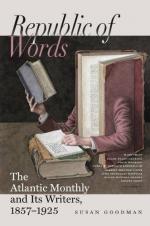and from this contact of select intelligences of diverse
vocation has resulted the choicest wit and the most
genial companionship. If from special we turn
to general associations, from biography to history,
the same prolific affinities are evident, whereby
the artist becomes an interpreter of life, and casts
the halo of romance over the stern features of reality.
Hampton Court is the almost breathing society of Charles
the Second’s reign; the Bodleian Gallery is
vivid with Britain’s past intellectual life;
the history of France is pictured on the walls of
Versailles; the luxury of color bred by the sunsets
of the Euganean hills, the waters of the Adriatic,
the marbles of San Marco, and the skies and atmosphere
of Venice, are radiant on the canvas of Titian, Tintoretto,
and Paul Veronese; Michel Angelo has embodied the
soul of his era and the loftiest spirit of his country;
Salvator typified the half-savage picturesqueness,
Neapolitan Claude the atmospheric enchantments, Carlo
Dolce the effeminate grace, Titian the voluptuous
energy, Guido the placid self-possession, and Raphael
and Correggio the religious sentiment of Italy; Watteau
put on canvas the
fete champetre; the peasant-life
of Spain is pictured by Murillo, her asceticism by
the old religious limners; what English rustics were
before steam and railroads Gainsborough and Moreland
reveal, Wilkie has permanently symbolized Scotch shrewdness
and domesticity, and Lawrence framed and fixed the
elegant shapes of a London drawing-room; and each
of these is a normal type and suggestive exemplar to
the imagination, a chapter of romance, a sequestration
and initial token of the characteristic and the historical,
either of what has become traditional or what is forever
true.
The indirect service good artists have rendered by
educating observation has yet to be acknowledged.
The Venetian painters cannot be even superficially
regarded, without developing the sense of color; nor
the Roman, without enlarging our cognizance of expression;
nor the English, without refining our perception of
the evanescent effects in scenery. Raphael has
made infantile grace obvious to unmaternal eyes; Turner
opened to many a preoccupied vision the wonders of
atmosphere; Constable guided our perception of the
casual phenomena of wind; Landseer, that of the natural
language of the brute creation; Lely, of the coiffure;
Michel Angelo, of physical grandeur; Rolfe, of fish;
Gerard Dow, of water; Cuyp, of meadows; Cooper, of
cattle; Stanfield, of the sea; and so on through every
department of pictorial art. Insensibly these
quiet but persuasive teachers have made every phase
and object of the material world interesting, environed
them with more or less of romance, by such revelations
of their latent beauty and meaning; so that, thus
instructed, the sunset and the pastoral landscape,
the moss-grown arch and the craggy seaside, the twilight
grove and the swaying cornfield, an old mill, a peasant,
light and shade, form and feature, perspective and
anatomy, a smile, a gesture, a cloud, a waterfall,
weather-stains, leaves, deer,—every object
in Nature, and every impress of the elements, speaks
more distinctly to the eye and more effectively to
the imagination.




